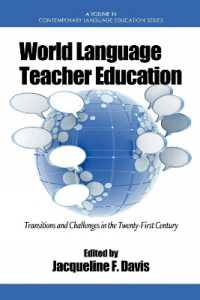- ホーム
- > 洋書
- > 英文書
- > Literary Criticism
Full Description
Winner, Charles Hatfield Book Prize, Comic Studies Society, 2020
A CHOICE Outstanding Academic Title, 2019
The history of America's civil rights movement is marked by narratives that we hear retold again and again. This has relegated many key figures and turning points to the margins, but graphic novels and graphic memoirs present an opportunity to push against the consensus and create a more complete history. Graphic Memories of the Civil Rights Movement showcases five vivid examples of this:
Ho Che Anderson's King (2005), which complicates the standard biography of Martin Luther King Jr.; Congressman John Lewis's three-volume memoir, March (2013-2016); Darkroom (2012), by Lila Quintero Weaver, in which the author recalls her Argentinian father's participation in the movement and her childhood as an immigrant in the South; the bestseller The Silence of Our Friends, by Mark Long, Jim Demonakos, and Nate Powell (2012), set in Houston's Third Ward in 1967; and Howard Cruse's Stuck Rubber Baby (1995), whose protagonist is a closeted gay man involved in the movement.
In choosing these five works, Jorge Santos also explores how this medium allows readers to participate in collective memory making, and what the books reveal about the process by which history is (re)told, (re)produced, and (re)narrativized. Concluding the work is Santos's interview with Ho Che Anderson.
Contents
Acknowledgments
Introduction. Graphic Memories in "Black and White"
Chapter 1. The Icon of the Once and Future King
Chapter 2. Bleeding Histories on the March
Chapter 3. On Photo-Graphic Narrative: "To Look—Really Look" into the Darkroom
Chapter 4. The Silence of Our Friends and Memories of Houston's Civil Rights History
Chapter 5. Tropes, Transfer, Trauma: The Lynching Imagery of Stuck Rubber Baby
Epilogue. Cyclops Was Right: X-Lives Matter!
Appendix. A Conversation with Ho Che Anderson, Author-Artist of King
Notes
Works Cited
Index








